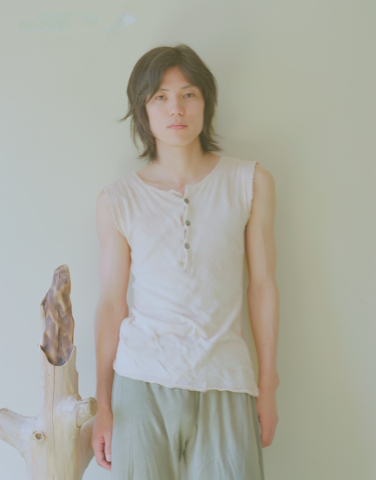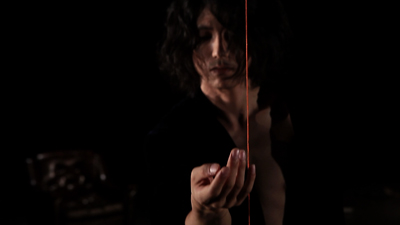TSUYOSHI SHIRAI
PEOPLEText: Fumi Hirota
TSUYOSHI SHIRAI is a dancer, choreographer and founder of the Contemporary Dance Group daneto, which performs dance, music and video works. The groups performances, which feature collaboration with contemporary music and a wide range of artists, have been well received both at home and abroad.
In 2004, Shirai performed the solo work “mass, slide, &.” In 2011, he created and presented a new visual work based on “mass, slide, &.” called “mass, slide, &. in frames” at YCAM. He has been trying many new things not only showing his visual works on the web but also make all materials downloadable. He describes this new creation as “dance as a visual work.” We asked Shirai to explain his views on the difference between theatrical and video works.

Photo: TSUYOSHI SHIRAI
Please introduce your self and details regarding your activity. Please share how you became an actively involved choreographer and dancer.
Appeared in performances by Kim Itoh + the Glorious Future in 1996-2000. Helped establish “Study of Live works baneto” in 1998, and received the Prix d’Auteur de Conseil Générale de la Seine-Saint-Denis in 2000. In 2004, unveiled “mass, slide ,& .”, which won a first prize at the Toyota Choreography Award in 2006. As a dancer, Shirai appeared in ”Devil’s Story” choreographed by Yuri Ng (2004-05), and “Kin-Jiki (Forbidden Colors)” choreographed by Kim Itoh (2005). In 2006, launched the company “AbsT”, and produced the pieces “Shihani – subsoil” and “THECO-zako-”, to be performed with seven contemporary musicians, in 2007. Won the first Japan Dance Forum Award in the same year. Since 2006, he has been collaborating with the famous Arditti String Quartet on John Cage’s “Apartment House 1776”, touring around ten major Japanese cities. In 2007, he was involved in “true” , a collaborative work by ten artists conceived in-residence and first performed at YCAM before embarking on an ongoing tour around Europe and Brazil among others. In 2009 and ’10 he made ”Blue Lion” and ”Still Life” respectively, both of which were produced and premiered in Kyoto. Also conducted the ” surround garden” workshop themed around sound and physical expression at YCAM in August 2010.

‘mass, slide ,& . in frames’, 2011, YCAM Commissioned work
The new visual work that was presented at YCAM was based on the 2004, Shirai performed the solo work “mass,slide, &.” What kind of work is this after all? please explain.
“mass,slide, &.” is a dance art work which was created based on theatrical personal performance series. Even before I have been creating solo work but acctually putting all elements including planning, directing, coreographing, performing all in one performance in a perfestional way has a large meaning for this work. The title in one word stands for “massiveness”.
I talked with Murakami, who supported me with directing as a creative manager regarding the title we put in terms of a microscope’s preparation glass impression. Preparation glass is a slide glass which has water in the upper layer and has a cover glass on top. The “slide” with in the title means the cover glass which seams to float or sticked to such space between like the space between the microscope. In order to feel the existence there is something happening with in the atmosphere might be something that is moved to instinct. If there is something heavy with in the space, time which relates to each other then that could be seen part of every day life even for dance, you could feel it this way.
The connection between ourselves and things, things to things even they stop between them. They still have a part where they don’t stop and continue to move. When you think of touching things, holding such movement has some kind of existence and could figure out a distance between them which could be passed through where such feeling is created. Mass and existence at the same time, things and bodies connection with a “specific case” is the concept for this art work.

Tsuyoshi Shirai ‘mass, slide ,& .’, 2004. photo: Toshihiro Shimizu
Dance work “mass, slide,&.” remake into a film art work. Dance and film are two different ways of presenting your work, what do you think the difference between dance and film.
From a performer who used to perform on stage might not like the idea turning their work into filmed work. I have the same feeling. There are things that you could only see it in live. Only could feel and understand it in live, simply do not like the idea seeing one self or their own voice filmed which make them feel uneasy. That is why they feel the way they are, when they get their art work in this case dance filmed. It might be away to get by with it, but for stage performance it has it’s stage methods. Dancing in front of viewers and dancing in an open rehearsal studio by them selves is different. Dance and directors could produce the traveling distance with in a live performance in front of viewers.
For example, approaching the viewers then withdrawing, an effective way of approaching at one point and turning around. Creating this performance by understanding the atmosphere and through their experience to make such performance. Such performance would be difficult to explain through film. That is why it is important to know how to perform specialy for film as a coreographer and dancer through their experience or else it is difficult to create a nice filmed performance. Stage performance, it is important for the person who is filming but also the coreographer it self to know what to do in order to express through the film using their istincts or else it would not grow. That is my focus where I wanted to study the most.

‘mass, slide ,& . in frames’, 2011, YCAM Commissioned work
Filmed work of “mass, slide, &. in frames” shows how you have not only performed but also participating as filming and editing, processing. Please share your views regarding your interest and using film as away of showing your work.
I was experienced in Video production, including one used on stage. I started to dance and began to produce Videos at about the same time. By the time the popular video cameras were produced, the handy cam, filmed my own dance and also other dancers and scenery which I repeatedly continued. At the time it was popular and those ideas were created. At the same time, DVD, etc. got popular, where now you can see the great video works. When it turns out this way, it becomes difficult to produce quality film work and being unable to meet its own satisfaction. It feels like losing the freshness.
When the old PV were aired just after the death of Michael Jackson, the awareness of “watching Dance on the video” increased. As I remember since I was in junior high and high school, the late-night television show which showed videos which affected and interest in dancing. I realized the importance of filmed performance which we could see even after ones death. In addition, currently on YouTube, we can watch various images from Forsythe and Pina Bausch. Compared to before, with increased exposure to various information via video, the recipient can not only have access to biased information but also choose their own information of there choice. There is a chance to meet influential information unconsciously. When I thought in such similar terms and conditions, my feeling of wanting to do the same, want to create my own video work, and to leave my own work got stronger.
What did you think when you filmed, and participated in the editing process.
It is hard for the body to keep up and try to dance while imagining the movements while filmed. When you dance it is tiring but it also has a sense of satisfaction as well. Usually it is fine. But there are times when I look back at the Video and often “I wish I had this way”. I noticed various points like camera angles and lighting. Often the first time to experience how communication during the shooting. To think what kind of instructions or directions I should give in order to transmitted so we can share the same concepts. Compared to getting involved with people in the theatrical productions, I have a hard time getting used to the filming site, in a sense where often not used to.
Worry about “the pause” with in the dance during the editing process. In this work, because there are props, the relationship between the rhythm with in the dance has been established a little. However, from the Video we could see a part with in the dance where for a moment where I’m not sure what that dancing stands for and the “pause” is sometimes too short or too long. It is different when you have customers. So for those sections where it needs to be cut or adjust the speed I have such an impression that the choreograph is corrected continuously again and again. Such task reminds of teaching choreograph to the dancer on stage.

‘mass, slide ,& . in frames’, 2011, YCAM Commissioned work
As an instructor for the workshop at YCAM “surround garden“where the relationship between “sounds and body” was focused in August last year. Do you have any Activities, themes you will like to work on in the future?
Instructor for a workshop requires different ideas, effort, courage. No to be able to create or dance. For such a profetional work shop, they should have a good professional choreographer…. You can not compare the burden difference between dancing in front of 200 spectators, and a workshop with 10 participants face-to-face. When a “presentation” is asked for a workshop the programs will also change as well. The workshop for me is part of a learning experience and is a enjoyable site. Resent video work might continue with installation. Not concrete yet, but it’s more conscious relationship with art and dance, visual approach to work with choreographer and dance which I will like to spread the activities further. From making this work, I realized also have a deeper interest in a camera. Especially for the dance, rather than video, and photos they have more phisical reality. While keeping in mind the relationship between dance and installation, Video, photos, etc., which I would like to explore even further.
Text: Fumi Hirota
Translation: Julie Morikawa





